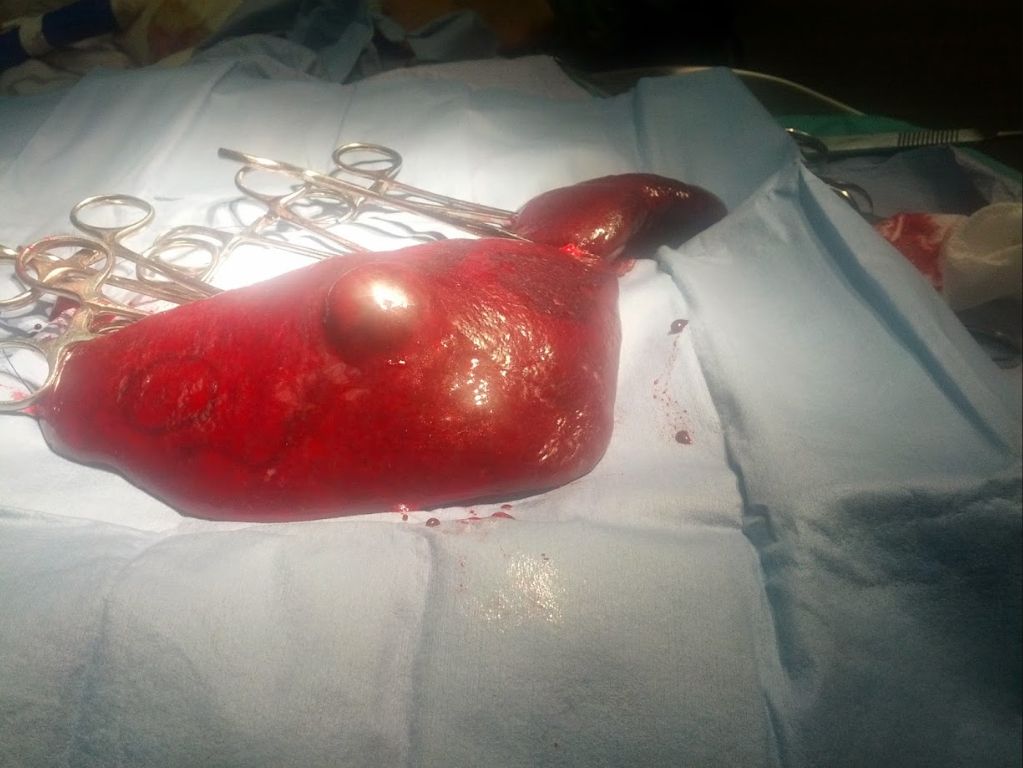Introduction
Spleen removal (splenectomy) surgery is performed in dogs to treat various conditions involving the spleen, such as cancer (hemangiosarcoma, lymphoma), benign masses (nodular hyperplasia), twisting (gastric dilatation volvulus), injury, or rupture (1). During surgery, the spleen is fully removed. This can lead to complications after surgery, as the spleen plays important roles in immunity, blood cell production, and blood clotting.
Splenectomy is a major surgery that requires general anesthesia. There are risks associated with anesthesia and the procedure itself. Dogs will require intensive monitoring and care after surgery. While many dogs recover well, potential complications should be understood when considering splenectomy.
Common Complications
Some of the most common complications after a splenectomy in dogs include hemorrhage, infection, and pancreatitis.
Hemorrhage
Excessive bleeding is one of the most common early complications following spleen removal surgery in dogs. Hemorrhage can occur during or after the procedure, either associated with issues related to blood clotting or not. According to research, hemorrhage was the most frequent complication in a study looking at dogs after splenectomy, occurring in around 11% of cases [1].

Infection
Infections can also develop after spleen removal surgery. Sources of infection include the incision site, abdominal cavity, or systemic spread. Antibiotics are commonly given to help prevent infections. Proper sterile technique during surgery and keeping the incision clean after can help minimize the risk of infection.
Pancreatitis
Pancreatitis is another potential complication following splenectomy in dogs. Inflammation of the pancreas can occur due to manipulation of the organ during surgery or other factors. Symptoms of pancreatitis include vomiting, abdominal pain, and loss of appetite. Pancreatitis ranges in severity and is typically managed with supportive care and medications.
Hemorrhage
Hemorrhage is one of the most common and serious complications after spleen removal surgery in dogs. It occurs when blood leaks from the splenic blood vessels into the abdomen. According to one study, hemorrhage was reported in over 20% of dogs after splenectomy (Dillon, 1980).
The causes of post-splenectomy hemorrhage include inadequate surgical hemostasis, clotting disorders, and increased friability of the splenic vessels. Splenectomized dogs are also more susceptible to hemorrhage due to the spleen’s role in storing platelets and initiating clotting (Patten, 2016).
Symptoms of hemorrhage include weakness, pale gums, distended abdomen, vomiting, collapse, and hypovolemic shock. Owners may observe blood seeping from the surgical incision as well. Diagnosis is made through laboratory tests, imaging, and abdominal fluid analysis.
Treatment consists of supportive care such as IV fluids, blood transfusions, and oxygen therapy. The abdomen may be explored again surgically to find and stop sources of bleeding. Medications can help improve clotting. Close monitoring is essential, as hemorrhage can quickly become fatal without prompt treatment.
Preventive measures include meticulous surgical technique, partial splenectomy when possible, and administering drugs to improve clotting in the postoperative period (Dillon, 1980). When hemorrhage occurs, early intervention is key to save a dog’s life.
Infection
One of the most common and serious complications after spleen removal in dogs is infection. With the spleen removed, dogs lose an important part of their immune system that helps filter bacteria and prevent infections [1]. This puts them at higher risk for developing bacterial infections, especially in the first few weeks after surgery.
Some of the most common infections after splenectomy include sepsis, meningitis, peritonitis and abscesses. These are often caused by bacteria normally filtered by the spleen, such as Capnocytophaga canimorsus. Dogs are especially prone to infection in the abdomen and incision site [2].

Preventing infection involves keeping the incision site clean, frequent hand washing when caring for the dog, and monitoring for signs of infection. Antibiotics may also be prescribed. Symptoms include lethargy, loss of appetite, fever, draining incision, vomiting, diarrhea, and abdominal pain or swelling. Any signs of infection should be reported to the veterinarian immediately.
Pancreatitis
One of the known complications after splenectomy in dogs is pancreatitis. The spleen helps filter the blood and block bacteria from entering the pancreas and liver. Without the spleen, these organs become more vulnerable to infection [1]. This puts dogs at a higher risk of developing pancreatitis after spleen removal.
Other risk factors for post-splenectomy pancreatitis include obesity, high-fat diets, hyperlipidemia (high blood lipids), and concurrent diseases. The lack of spleen filtration in combination with these factors is thought to allow pancreatic inflammation to occur more readily [2].
Veterinarians manage post-splenectomy pancreatitis by addressing any underlying illnesses, restricting food and water intake, providing intravenous fluids and medications, and monitoring bloodwork. Dogs may require hospitalization for more severe cases. Long-term management involves feeding a low-fat prescription diet and maintaining a healthy body weight.

Clotting Disorders
One of the major complications following a splenectomy in dogs is an increased risk for clotting disorders such as thrombosis or disseminated intravascular coagulation (DIC) (Kim, 2019). The spleen plays an important role in filtering old and abnormal red blood cells from circulation. Without the spleen, there is an increase in abnormal red blood cells, platelet numbers, and clotting factors, leading to a hypercoagulable state.
Portal vein thrombosis is one of the most concerning clotting complications post-splenectomy, as it can cut off blood supply to the liver and be fatal if not caught early (McPhetridge et al., 2022). DIC, a serious clotting disorder where small clots form rapidly throughout the body, is also a risk following splenectomy.
To help prevent clotting disorders after spleen removal, vets may prescribe anti-coagulant medications like aspirin or heparin. Careful monitoring of the dog’s platelet count, clotting times, and fibrinogen levels is also important to catch any concerning trends early on. Avoiding situations that increase clotting risk, like trauma or hyperthermia, can also help reduce complications.

Incision Complications
One potential complication following a splenectomy in dogs is issues with the surgical incision site. According to a blog post from Emergency Pet Clinics, two key incision complications to watch out for are dehiscence and hernia [1].
Dehiscence refers to the breakdown or reopening of an incision. It occurs when the sutures or staples fail, causing the incision to split open. Dehiscence is usually caused by increased abdominal pressure, infection of the incision, or inadequate healing of the incision. Signs of dehiscence include discharge, redness, swelling, and visible splitting of the incision. This complication requires rapid veterinary assessment and often surgical repair.
Hernia refers to the protrusion of organs or tissue through a weak spot in the muscle or surrounding tissue. Incisional hernias can occur after a splenectomy if the abdominal wall does not heal properly. A visible bulge may be seen under the skin at the incision site. Emergency Pet Clinics says hernias are most likely to develop 2-4 weeks after surgery. Surgical hernia repair is typically needed to push the protruding tissue back into place and reinforce the abdominal wall.
Gastrointestinal Issues
Some dogs may experience gastrointestinal issues after a splenectomy, primarily diarrhea, vomiting, and increased appetite. Dogs may have diarrhea due to changes in digestive function after the spleen removal. The spleen helps filter the blood and remove old red blood cells, so its removal can impact digestion and absorption of nutrients (source).
Vomiting may also occur after surgery, potentially due to motility changes or inflammation in the gastrointestinal tract. Some dogs have increased appetite and eat more food after the spleen is removed. This may be due to altered hormone levels that control hunger and fullness. Careful monitoring of food intake, diet changes, anti-nausea medication, or other treatments may help manage GI issues (source).
Overall, dogs usually adjust within a few weeks after surgery, but some may have chronic digestive problems. Close communication with your veterinarian can help properly treat and manage any persistent gastrointestinal side effects after a splenectomy.
Long-term Care
After a splenectomy, dogs require careful monitoring and some lifestyle changes for the long-term. Owners should watch for signs of infection, bleeding, or other complications and contact their veterinarian immediately if they notice anything abnormal.
Medications may be prescribed for several weeks after surgery to prevent blood clotting issues. According to the Emergency Pet Clinics, most dogs need to take antibiotics and pain medications for 7-10 days after surgery. Some vets also prescribe medications to protect the stomach lining since nonsteroidal anti-inflammatory pain relievers can cause gastrointestinal irritation.[1]
Lifestyle changes are necessary as well. Confinement and exercise restriction are required for 10-14 days to allow the incision to fully heal. Owners will need to limit activity to short, leashed walks. Jumping, running, and rough play should be avoided during the recovery period. Providing a quiet, comfortable place for the dog to rest is important.[2]
After the incision has healed and activity restrictions are lifted, moderate exercise can be gradually reintroduced. However, dogs who have undergone splenectomy surgery will require monitoring for the remainder of their lives as they are at lifelong risk for certain disorders without a spleen.
When to Seek Help
After a splenectomy, it’s important to monitor your dog closely for any warning signs or complications that may require veterinary attention. According to the Davidson Veterinary Clinic https://davidsonvet.com/splenectomy/, some key things to watch for include:
- Fever
- Vomiting or diarrhea
- Loss of appetite or lethargy
- Pale gums or other signs of anemia or internal bleeding
- Discharge or swelling around the incision site
- Abdominal pain or bloating
The Direct Veterinary Surgeons recommend contacting your vet if your dog exhibits https://directvetsurg.com/wp-content/uploads/2020/02/Splenectomy.pdf:
- Reluctance to eat
- Vomiting
- Diarrhea
- Depression
- Abdominal swelling
- Discharge from the incision
According to ToeGrips https://toegrips.com/can-dog-live-without-spleen/, contact your veterinarian immediately if you notice any signs of internal bleeding, infection, or other complications after surgery. It’s important to monitor the incision site closely and watch for any changes in behavior or appetite that could indicate a potential problem requiring veterinary attention.